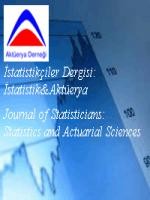Hasar sıklıkları için sıfır yığılmalı kesikli modeller
Sıfır yığılmalı regresyon modelleri genelleştirilmiş doğrusal modellerin özelleştirilmiş biçimi olup, veri kümesinin sıfır değerinde aşırı yığılma gösterdiği durumda sıfır değeri için yeniden ağırlıklandırma yapılarak elde edilmektedir. Bu çalışmada, literatürde yaygın olarak kullanılan sıfır yığılmalı regresyon modelleri ele alınmış ve Karayolları Motorlu Araçlar Zorunlu Mali Sorumluluk Sigortası’nda belirli bir sürede meydana gelen hasar sayıları sıfır yığılmalı regresyon ile modellenerek uygun dağılım belirlenmiştir. Çalışmanın uygulama bölümünde Trafik Sigortaları Bilgi Merkezi’nden (TRAMER) alınan veri kümesi kullanılmıştır. İki farklı değişken kümesi ile regresyon modelleri oluşturulmuştur. Oluşturulan regresyon modelleri model seçim ölçütleri dikkate alınarak karşılaştırılmış ve veri kümesine en uygun model belirlenmiştir. Her iki değişken kümesi ile elde edilen sonuçlar, klasik sayı modellerinin sıfır değerindeki yığılmanın açıklanmasında yetersiz olduğunu, hasar sayılarının modellenmesinde sıfır yığılmalı regresyon modellerinin klasik sayı modellerine tercih edilmesi gerektiğini göstermiştir
Anahtar Kelimeler:
Sıfır yığılmalı regresyon modelleri, Aşırı yayılım, Hasar sayısı dağılımları, Zorunlu trafik sigortası, Genelleştirilmiş doğrusal modeller
Zero-inflated discrete models for claim frequencies
Zero-inflated regression models are a special type of generalized linear models and obtained by reweightingfor zero when data has excess zeros.In this study, the use of zero-inflated regression models to model claimfrequencies for motor third party liability insurance is investigated. In application, data taken from MotorThird Party Liability Insurance Center (TRAMER) is used. Two regression models are constructed for twodifferent variable sets. The best (or the most suitable) model is choosen by taking into account model selectioncriteria. The results obtained for two variable sets show that classical count models do not explain the densityaccumulation mass at zero value and zero-inflated regression models should be preferred to classical countmodels while modeling claim count data.
Keywords:
Zero-inflated regression models, Overdispersion, Claim count distributions, Motor third party liability insurance, Generalized linear models,
___
- Boucher, J.-P., Denuit, M., Guillen, M., 2007, Risk Classification for Claim Counts: Mixed Poisson, Zero- Inflated Mixed Poisson and Hurdle Models, North American Actuarial Journal, 11, 4, 110-131.
- Dean, C., Lawless, J.F., 1989, Test for Defecting Overdispersion in Poisson Regression Models, Journal of American Statistical Association, 84, 467-472.
- Denuit, M., Marechal, X., Pitrebois, S., Walhin, J.F., 2007, Actuarial Modelling of Claim Counts: Risk Classification, Credibility and Bonus-Malus Systems, 356p.
- Faddy, M.J., 1998, Stochastic Models for Analysis of Species Abundance Data, Statistics in Ecology and Environmental Monitoring, 2, D.J. Fletcher, L. Kavalieris, B.F.J. Manly (eds.), Dunedin: University of Otago Press, 33-40.
- Famoye, F., Singh, K.P., 2006, Zero-Inflated Generalized Poisson Regression Model with an Application to Domestic Violence Data, Journal of Data Science, 4, 117-130.
- Flynn, M., Francis, A.,L., 2009, More Flexible GLMs: Zero Inflated Models and Hybrid Models, CAS Ratemaking and Product Management Seminar.
- Giles, D., 2010, Notes on the Zero Inflated Poisson Model, Department of Economics, University of Victoria.
- Greene, W. H., 1994, Accounting for Excess Zeros and Sample Selection in Poisson and Negative Binomial Regression Models, Technical report.
- Lambert, D., 1992, Zero-Inflated Poisson Regression, With an Application to Defects in Manufacturing, Technometrics, 34, No.1.
- Land, K.C., McCall, P.L., Nagin, D.S., 1996, A Comparison of Poisson, Negative Binomial and Semiparametric Mixed Poisson Regressive Models with Empirical Applications to Criminal Careers Data, Sociological Methods and Research, 24, 387-442.
- McCullagh, P., Nelder, J.A., 1989, Generalized Linear Models, 2nd Ed., Chapman and Hall, London, 511p.
- Mullahy, J., 1986, Specification and Testing of Some Modified Count Data Models, Journal of Econometrics, 33, 341-365.
- Özmen, İ., Demirhan, H., 2010, A Bayesian Approach for Zero-Inflated Count Regression Models by Using the Reversible Jump Markov Chain Monte Carlo Method and an Application, Communications in Statistics- Theory and Methods, 39, 2109-2127.
- Ridout, M., Demetrio, C.G.B., Hinde, J., 1998, Models for Count Data with Many Zeros, International Biometric Conference, Capetown December.
- Shankar, V., Milton, J., Mannering, F., 1997, Modeling Accident Frequencies As Zero-Altered Probability Processes: An Emprical Inquiry, Accident Analysis and Prevention, 29, 6, 829-837.
- Van den Broek, J., 1995, A Score Test for Zero-Inflation In a Poisson Distribution, Biometrics, 51, 738-743.
- Welsh, A.H., Cunningham, R.B., Donnelly, C.F., Lindenmayer, D.B., 1996, Modelling the Abundance of Rare Species: Statistical Models for Counts with Extra Zeros, Ecological Modeling, 88, 297-308.
- Yip, K.C.H., Yau, K.K.W., 2005, On Modeling Claim Frequency Data In General Insurance With Extra Zeros, Insurance: Mathematics and Economics, 36, 153-163.
- ISSN: 1308-0539
- Yayın Aralığı: Yılda 2 Sayı
- Başlangıç: 2008
- Yayıncı: Aktüerya Derneği
